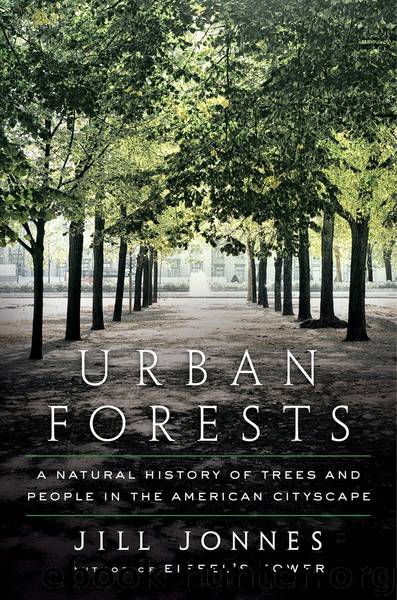Urban Forests by Jill Jonnes

Author:Jill Jonnes
Language: eng
Format: epub
Publisher: Penguin Publishing Group
Published: 2017-05-18T15:46:11+00:00
CHAPTER FIFTEEN
“We Stand a Great Chance of Seeing a Return of the Stately and Valuable American Elm”: Rebirth of an Iconic Tree?
USDA horticulturist Susan Bentz with USDA scientist Denny Townsend with his American elms at trial fields in Glenn Dale, Maryland. (Courtesy of the U.S. National Arboretum.)
In 1989, at the seventy-acre National Arboretum facility in suburban Glenn Dale, Maryland, USDA plant pathologist Denny Townsend was finally ready for the great American elm survivor contest. He was preparing to test how the few, rare American elm clones and cultivars—survivors of the original waves of Dutch elm disease and years of further fungal assault in field trials—now stacked up against one another. “We were not trying to advocate any particular tree,” he says, “we were just doing a scientific experiment.”
One journalist driving into the USDA Glenn Dale facility gazed around and at first glance admired “tree-shaded lawns bearing resemblance to a posh country club’s grounds.” But after a closer look, he likened the facility, with its acres of semiabandoned test fields and hodgepodge of decaying greenhouses, wooden storage barns, and concrete-block offices, to “an obscure research station in Ukraine.” He had come to meet Townsend, who ran his elm operation out of a spartan stucco lab and office with “the ambience of a small-engine repair shop, its drabness redeemed only by red celosia flowers blooming at the doorway.” In fact, the building had originally served as “a cold-storage building—just concrete blocks lined with six inches of cork.”
David Fairchild had established this then-rural outpost in 1919 as one of four national Plant Introduction Stations, a place of quarantine for the ornamental and commercial foreign plants sent home by plant explorers like Frank Meyer. Suburbs and highways now encircled the USDA fields, many of them cleared and fallow, while others were still filled with rows of old fruit and nut orchards. A few of Fairchild’s original Japanese cherry trees—relocated from In the Woods and more than eighty years old—still bloomed here each spring, while Meyer’s memory lived on in a row of old conifers and, of course, his most influential introduction, the Callery pear, which still held pride of place. Glenn Dale even had a towering dawn redwood from the 1948 China expedition.
Townsend’s great American elm contest would include nine different cultivars. Four of these cloned specimens had emerged from his own decades of research and included a tree he and a colleague had first spotted on a 1976 trip to Springfield, Ohio. “We noticed this American elm on Interstate 70 that looked pretty great,” he recalls. They kept an eye on it for another four years, watching in admiration as it flourished while all the nearby American elms withered away from DED. “We got permission from the landowner to propagate it. It was a wild native tree.” This notable survivor was dubbed Clone 680.
Townsend also had been growing on his Glenn Dale plantations the fifth of the nine clones in the trial, this being R 18-2, the most tolerant of the Cornell University–Boyce Thompson Institute trees dating back to the 1930s.
Download
This site does not store any files on its server. We only index and link to content provided by other sites. Please contact the content providers to delete copyright contents if any and email us, we'll remove relevant links or contents immediately.
| Africa | Americas |
| Arctic & Antarctica | Asia |
| Australia & Oceania | Europe |
| Middle East | Russia |
| United States | World |
| Ancient Civilizations | Military |
| Historical Study & Educational Resources |
Cat's cradle by Kurt Vonnegut(14785)
Pimp by Iceberg Slim(13808)
Underground: A Human History of the Worlds Beneath Our Feet by Will Hunt(11848)
4 3 2 1: A Novel by Paul Auster(11821)
The Radium Girls by Kate Moore(11641)
Wiseguy by Nicholas Pileggi(5334)
American History Stories, Volume III (Yesterday's Classics) by Pratt Mara L(5141)
Perfect Rhythm by Jae(5083)
The Fire Next Time by James Baldwin(5033)
Paper Towns by Green John(4812)
Pale Blue Dot by Carl Sagan(4632)
A Higher Loyalty: Truth, Lies, and Leadership by James Comey(4567)
The Mayflower and the Pilgrims' New World by Nathaniel Philbrick(4287)
The Doomsday Machine by Daniel Ellsberg(4253)
Killers of the Flower Moon: The Osage Murders and the Birth of the FBI by David Grann(4197)
Too Much and Not the Mood by Durga Chew-Bose(4105)
The Sympathizer by Viet Thanh Nguyen(4100)
The Borden Murders by Sarah Miller(4032)
Sticky Fingers by Joe Hagan(3916)
